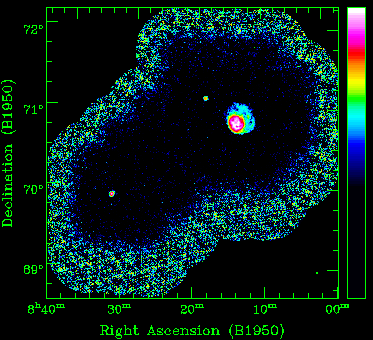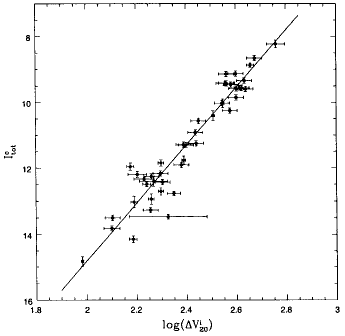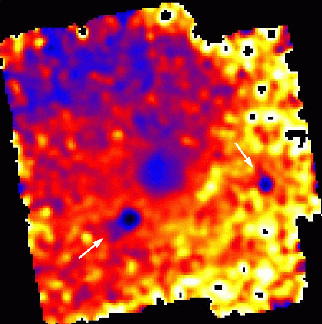
Preliminary HI mosaic of the outer parts of the M81 Group. HoII (top-right), M81dwA(top-left), and UGC4483 (bottom-left) can easily be seen, but no intergalactic HI is detected.

Below is a description of some of the work I have done and some of the projects I have participated in concerning clusters and groups of galaxies. Unfortunately, lack of time prevents me from putting on the web everything I am involved in, but my publications list (which is up-to-date) should alleviate this problem somewhat.
My interest in clusters and groups of galaxies is mostly related to how they affect galaxy evolution. As such, I am mostly interested in issues such as ram pressure stripping, intergalactic HI clouds (and their relationship to High Velocity Clouds), and the cosmological distance ladder (Tully-Fisher relation and Fundamental Plane).
| M81 Group | Fornax Cluster |
M81 Group:
Following my work on the dwarf galaxy
HoII, which revealed evidence of ram pressure and thus an
intra-group medium (IGM) in the M81 group, Jacqueline van
Gorkom (Columbia
University), Fabian Walter (MPIA Heidelberg), Claude Carignan (Université
de Montréal), and I have mosaiced in HI (VLA ) a large area on the
outskirts of the M81 group. Encompassing HoII, UGC4483, and Kar52
(M81dwA), the survey should (i) confirm the peculiar HI morphology
observed in HoII; (ii) assert whether
UGC4483 and/or M81dwA also show evidence of ram pressure stripping;
(iii) verify that the three galaxies are not interacting; and (iv)
constrain the existence of a cold intergalactic medium and/or
high-velocity clouds (HVCs). The M81 group is not known to possess
extended X-ray emission and is E/S0 poor. The observations will thus
test whether the hot IGM picture is valid or whether tidal
interactions offer an alternative, better explanation for HoII's
morphology. The presence of an IGM in such a poor group would have
important consequences for the evolution of group members. Due to the
excellent sensitivity, we should also be able to detect the
counterparts to both the classical HVCs (small clouds in the Galaxy
halo) and the putative minihalos left from galaxy formation (if
present). The survey analysis should be completed in a few months and
a paper submitted soon after that.
Fornax Cluster:
As a first year project during my graduate studies in
astronomy & astrophysics at Mount
Stromlo and Siding Spring Observatories, I studied the Fornax
cluster in collaboration with Jeremy Mould ( NOAO) and Lister
Staveley-Smith (ATNF). The Fornax cluster
represents a crucial step in the extragalactic distance scale. We
carried out a new I-band luminosity - HI velocity width (I-band
Tully-Fisher) study of the cluster using an enlarged sample of
spiral galaxies. I-band CCD photometry (SSO
40-inch telescope) and 21 cm parameters (ATNF 64m Parkes
Radiotelescope) were measured for 23 members of Fornax and
compared with data for the Virgo cluster. We obtained an accurate
distance modulus of Fornax relative to Virgo of -0.06+/-0.15 mag. The
low scatter of Fornax galaxies around the Tully-Fisher relation make
the cluster an ideal calibrator given the current direct measurement
of its distance by the
HST Key Project on the Extragalactic Distance Scale. Furthermore,
the HI content of the galaxies does not seem affected by the cluster
environment. We used two different absolute calibration methods which
yielded an absolute distance to Fornax of 15.4+/-2.3 Mpc (absolute
distance modulus of 30.94+/-0.33 mag). A simple model then yields a
Local Group Virgocentric flow velocity of 224+/-90 km s^-1,
corresponding to a Hubble constant of 74+/-11 km s^-1 Mpc^-1 from the
Fornax data.

A paper describing this work has appeared in Bureau, M., Mould, J. R., & Staveley-Smith, L. 1996, ApJ, 463, 60. You can also download it here in preprint format.
Together with Caleb Scharf (Columbia University) and David Zurek (American Museum of Natural History), I also studied the hot gas content of the Fornax Cluster using X-rays. Focusing on the inner 1 degree, we obtained ten 50 ksec Chandra pointings in a mosaic centered on the central giant elliptical galaxy NGC1399. Regions as small as 100 pc are resolved and 771 X-ray point sources were detected. The intra-cluster gas exhibits a highly asymmetric morphology and temperature structure, dominated by a 180 kpc extended "plume" of low surface brightness, cool gas (about 1 keV) to the North-East of NGC1399, with a sharper edge to the South-West. The elliptical galaxy NGC1404 also exhibits a cool halo of X-ray gas, with a highly sharpened leading edge and a cometary-like tail, as it presumably falls into the cluster. We estimate that some 200-400 of the point sources are physically associated with Fornax. Confirming earlier works, we find that the globular cluster population in NGC1399 is highly X-ray active, extending to globulars which may in fact be intra-cluster systems. We also found that cluster galaxies inhabiting regions of low gas density are more likely to show X-ray activity. Not only does this correlate with the asymmetry of the intra-cluster gas, but also with an axis joining the center of Fornax with an infalling group 1 Mpc to the South-West. We thus suggest that Fornax may be experiencing an intergalactic "headwind" due to its motion relative to the surrounding large-scale structure.

A paper describing this work has appeared in Scharf, Zurek, & Bureau, M. 2005, ApJ, 633, 154. You can also download it here in preprint format.
In collaboration with Alister Graham (MSSSO), I am currently reanalysing the above Fornax cluster data in the hope of determining why we previously obtained such a short Fornax distance (the HST Key Project places Fornax farther than Virgo). For this, we are using an analog to the Fundamental Plane of early-type galaxies, built from the central surface brightness, scalelength, and rotation velocity of the disks. A paper summarizing our results should be submitted soon.
To go back to my Home Page, click here:
![]()
This page was last modified on October 28 2005